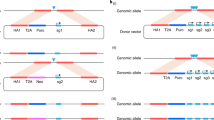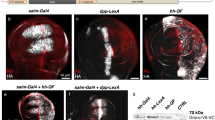Abstract
Precise excision of transposable elements in prokaryotes is a rare event which occurs at a significantly lower rate than transposition and other element-mediated events1. Thus, we were intrigued by a eukaryotic transposable element which seemed capable of precise excision at high frequencies. The white-crimson (wc) mutation in Drosophila, a highly unstable allele of the X-linked eye colour locus, white2, resulted from the insertion of a member of the foldback (FB) transposable element family3,4. This mutation reverts to its parental phenotype at a frequency of greater than 1 in 103 X chromosomes2. Characterization of these revertants by Southern blots of genomic DNA indicated that they resulted from loss of the wc insertion3. Here we report the nucleotide sequence of the excision point in these revertants, and conclude that the FB element responsible for the wc mutation is capable of precise excision at high frequencies.
This is a preview of subscription content, access via your institution
Access options
Subscribe to this journal
Receive 51 print issues and online access
$199.00 per year
only $3.90 per issue
Buy this article
- Purchase on Springer Link
- Instant access to full article PDF
Prices may be subject to local taxes which are calculated during checkout
Similar content being viewed by others
References
Kleckner, N. A. Rev. Genet. 15, 341–404 (1981).
Green, M. M. Genetics 56, 467–482 (1967).
Collins, M. & Rubin, G. M. Cell 30, 71–79 (1982).
Levis, R., Collins, M. & Rubin, G. M. Cell 30, 551–565 (1982).
Karess, R. E. & Rubin, G. M. Cell 30, 63–69 (1982).
Potter, S. S., Truett, M., Phillips, M. & Maher, A. Cell 20, 639–647 (1980).
Truett, M. A., Jones, R. S. & Potter, S. S. Cell 24, 753–763 (1981).
Potter, S. S. Nature 297, 201–204 (1982).
Calos, M. P. & Miller, J. H. Cell 20, 579–595 (1980).
Berg, D. E. et al. Cold Spring Harb. Symp. quant. Biol. 45, 115–124 (1981).
Foster, T. J., Lundblad, V., Hanley-Way, S., Halling, S. M. & Kleckner, N. Cell 23, 215–227 (1981).
Schaller, H. Cold Spring Harb. Symp. quant. Biol. 43, 401–408 (1979).
Kleckner, N. Cell 16, 711–720 (1979).
Egner, C. & Berg, D. E. Proc. natn. Acad. Sci. U.S.A. 78, 459–463 (1981).
Farabaugh, P. J., Schmeissner, U., Hofer, M. & Miller, J. H. J. molec. Biol. 126, 847–57 (1978).
Albertini, A. M., Hofer, M., Calos, M. P. & Miller, J. H. Cell 29, 319–328 (1982).
Rubin, G. M., Kidwell, M. G. & Bingham, P. M. Cell 30, 987–994 (1982).
O'Hare, K. & Rubin, G. M. Cell (submitted).
Messing, J. & Viera, J. Gene 19, 269–276 (1982).
Sanger, F., Nicklen, S. & Coulson, A. R. Proc. natn. Acad. Sci. U.S.A. 74, 5463–5467 (1977).
Sanger, F., Coulson, A. R., Barell, B. G., Smith, A. J. H. & Roe, B. A. J. molec. Biol. 143, 161–178 (1980).
Messing, J., Crea, R. & Seeburg, P. H. Nucleic. Acids Res. 9, 309–321 (1981).
Bolivar, F. et al. Gene 2, 95–113 (1977).
Rimm, D. L., Horness, D., Kucera, J. & Blattner, F. R. Gene 12, 301–309 (1980).
Author information
Authors and Affiliations
Rights and permissions
About this article
Cite this article
Collins, M., Rubin, G. High-frequency precise excision of the Drosophila foldback transposable element. Nature 303, 259–260 (1983). https://doi.org/10.1038/303259a0
Received:
Accepted:
Issue Date:
DOI: https://doi.org/10.1038/303259a0
This article is cited by
-
Insertional variability of four transposable elements and population structure of the midge Chironomus riparius (Diptera)
Molecular Genetics and Genomics (2011)
-
An FB-NOF mediated duplication of the white gene is responsible for the zeste 1 phenotype in some Drosophila melanogaster unstable strains
Molecular Genetics and Genomics (2006)
-
RYS1, a foldback transposon, is activated by tissue culture and shows preferential insertion points into the rye genome
Theoretical and Applied Genetics (2005)
-
FB elements can promote exon shuffling: a promoter-less white allele can be reactivated by FB mediated transposition in Drosophila melanogaster
Molecular Genetics and Genomics (2004)
-
Genetic and molecular analysis of a set of unstable white mutants in Drosophila melanogaster
Genetica (1996)
Comments
By submitting a comment you agree to abide by our Terms and Community Guidelines. If you find something abusive or that does not comply with our terms or guidelines please flag it as inappropriate.



